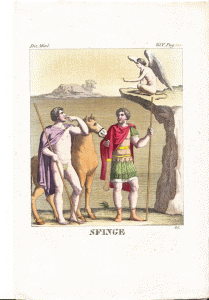G. C. (after Pietro Santi Bartoli), ‘Sfinge’, ca. 1825, hand coloured engraving, 14 x 12 cm. (page 23,6 x 15,5 cm.) (Decoration from the Tomb of the Nasoni), from: Dizionario d’ogni mitologia e antichità incominciato da Girolamo Pozzoli sulle tracce del Dizionario della favola di Fr. Noel, continuato ed ampliato dal prof. Felice Romani e dal dr. Antonio Peracchi. Vol.V, Milan: Batelli e (Ranieri) Fanfani 1825, p.606.
This coloured engraving illustrating the mythological creature of the sphinx (as indicated by its caption), is literally taken over from Bartoli dating from 1680.1 This book ilustrated and explained the archeological thrill of that day, a just disovered Roman tomb that was first believed to be the poet Ovid’s. It turned out to be the family vault of Quintus Nasonius Ambrosius, dating ca. 150 AD, depicting mythological scenes. This ‘Oedipus answering the sphinx’ formed part of an eleborate program on the back wall of the tomb, paired with Pegasus and related to Orpheus and Eurydice.
for more information of the recent reconstruction in colour, click here
1. Bartoli, Pietro Santi, (1635-1700), ‘Edipo resonde alla Sfinge’, 1680, engraving, tavola XIX in: Bellori, Giovanni Pietro, Delle Pitture antiche del Sepolcro de’Nasonii , nella Via Flaminia disegnate, ed intagliate alla similitudine degli antichi originali. Rome: Battista Bussotti 1680; https://archive.org/stream/lepittureantiche00bell#page/n7/mode/2up
